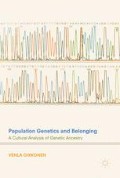Abstract
The chapter theorizes the temporal dynamic that underlies population genetic belonging through two novels: Kathleen O’Neal Gear and W. Michael Gear’s popular prehistoric romance People of the Raven, which imagines the life of Kennewick Man, and Margaret Drabble’s novel The Peppered Moth, which is centered on the mitochondrial analysis of ancient human remains very similar to the Cheddar case. The chapter develops the concept of evolutionary nostalgia to capture the two-way temporal longing that organizes population genetic belonging and renders the imagined past the location of futurity. Building on scholarship on queer time, genetic temporality, and collective memory, the chapter explores the conceptual and material complexities of how pasts and futures are seen as unfolding from genetic analysis.
Access this chapter
Tax calculation will be finalised at checkout
Purchases are for personal use only
Notes
- 1.
Feminist scholars in particular have critiqued narratives that bring together two mutually complementary lovers and thus mask the ideological tensions the narrative may have raised. For classic critiques, see Rachel Blau DuPlessis (1985) or Teresa de Lauretis (1984). See also Roof (1996), Pearce and Stacey (1995), or my article (Oikkonen 2010).
References
Attewell, Nadine. 2004. ‘Bouncy Little Tunes’: Nostalgia, Sentimentality, and Narrative in Gravity’s Rainbow. Contemporary Literature 45: 22–48.
Berlant, Lauren. 2011. Cruel Optimism. Durham: Duke University Press.
Boellstorff, Tom. 2007. When Marriage Falls: Queer Coincidences in Straight Time. GLQ: A Journal of Lesbian and Gay Studies 13 (2–3): 227–248.
Boym, Svetlana. 2001. The Future of Nostalgia. New York: Basic Books.
Clayton, Jay. 2002. Genome Time. In Time and the Literary, ed. Karen Newman, Jay Clayton, and Marianne Hirsch, 31–59. New York: Routledge.
Dawkins, Richard. 1995. River Out of Eden: A Darwinian View of Life. London: Phoenix.
de Lauretis, Teresa. 1984. Alice Doesn’t: Feminism, Semiotics, Cinema. Bloomington: Indiana University Press.
Dinshaw, C. 2007. Temporalities. In Middle English, ed. Paul Strohm, 107–123. Oxford: Oxford University Press.
Dinshaw, Carolyn, Lee Edelman, Roderick A. Ferguson, Carla Freccero, Elizabeth Freeman, Judith Halberstam, Annamarie Jagose, Christopher Nealon, and Nguyen Tan Hoang. 2007. Theorizing Queer Temporalities: A Roundtable Discussion. GLQ: A Journal of Lesbian and Gay Studies 13 (2–3): 177–195.
Drabble, Margaret. 2001. The Peppered Moth. London: Penguin Books.
DuPlessis, Rachel Blau. 1985. Writing Beyond the Ending: Narrative Strategies of Twentieth-Century Women Writers. Bloomington: Indiana University Press.
Edelman, Lee. 2004. No Future: Queer Theory and the Death Drive. Durham: Duke University Press.
Freeman, Elizabeth. 2010. Time Binds: Queer Temporalities, Queer Histories. Durham: Duke University Press.
Gear, Kathleen O’Neal, and W. Michael Gear. 2005. People of the Raven. New York: Tor.
Halberstam, J. 2005. In a Queer Time and Place: Transgender Bodies, Subcultural Lives. New York: New York University Press.
King, Mary-Claire, and Allan Wilson. 1975. Evolution at Two Levels in Humans and Chimpanzees. Science 188 (4184): 107–116.
Landsberg, Alison. 2004. Prosthetic Memory: The Transformation of American Remembrance in the Age of Mass Culture. New York: Columbia University Press.
Margoliash, Emanuel. 1963. Primary Structure and Evolution of Cytochrome C. Proceedings of the National Academy of Sciences 50 (4): 672–679.
M’charek, Amade. 2014. Race, Time and Folded Objects: The HeLa Error. Theory, Culture & Society 31 (6): 29–56.
Muller, Adam. 2007. Notes Toward a Theory of Nostalgia: Childhood and the Evocation of the Past in Two European ‘Heritage’ Films. New Literary History 37: 739–760.
Muñoz, José Esteban. 2009. Cruising Utopia: The then and there of Queer Futurity. New York: New York University Press.
Oikkonen, Venla. 2010. Mutations of Romance: Evolution, Infidelity, and Narrative. Modern Fiction Studies 56: 592–613.
———. 2013. Gender, Sexuality and Reproduction in Evolutionary Narratives. London: Routledge.
Pearce, Lynne, and Jackie Stacey, eds. 1995. Romance Revisited. New York: New York University Press.
Povinelli, Elizabeth A. 2011. Economies of Abandonment: Social Belonging and Endurance in Late Liberalism. Durham: Duke University Press.
Roof, Judith. 1996. Come as You Are: Sexuality and Narrative. New York: Columbia University Press.
———. 2007. The Poetics of DNA. Minneapolis: University of Minnesota Press.
Sarich, Vincent M., and Allan C. Wilson. 1967. Immunological Time Scale for Hominid Evolution. Science 158 (3805): 1200–1203.
Smith, Kimberly K. 2000. Mere Nostalgia: Notes on a Progressive Paratheory. Rhetoric and Public Affairs 3: 505–527.
Stolberg, Sheryl Gay. 2012. Obama Has Ties to Slavery Not by His Father but His Mother, Research Suggests. New York Times, July 30. Accessed March 9, 2017. http://www.nytimes.com/2012/07/30/us/obamas-mother-had-african-forebear-study-suggests.html
Swarns, Rachel L. 2012. Meet Your Cousin, the First Lady: A Family History, Long Hidden. New York Times, June 16. Accessed March 9, 2017. http://www.nytimes.com/2012/06/17/us/dna-gives-new-insights-into-michelle-obamas-roots.html
Turner, Stephanie S. 2007. Open-Ended Stories: Extinction Narratives in Genome Time. Literature and Medicine 26 (1): 55–82.
Wald, Priscilla. 2000. Future Perfect: Grammar, Genes, and Geography. New Literary History 31: 681–708.
Zuckerkandl, Emile, and Linus B. Pauling. 1962. Molecular Disease, Evolution, and Genic Heterogeneity. In Horizons in Biochemistry, ed. M. Kasha and B. Pullman, 189–225. New York: Academic Press.
Author information
Authors and Affiliations
Rights and permissions
Copyright information
© 2018 The Author(s)
About this chapter
Cite this chapter
Oikkonen, V. (2018). Evolutionary Nostalgia and the Temporality of Belonging. In: Population Genetics and Belonging. Palgrave Macmillan, Cham. https://doi.org/10.1007/978-3-319-62881-3_4
Download citation
DOI: https://doi.org/10.1007/978-3-319-62881-3_4
Published:
Publisher Name: Palgrave Macmillan, Cham
Print ISBN: 978-3-319-62880-6
Online ISBN: 978-3-319-62881-3
eBook Packages: Social SciencesSocial Sciences (R0)

